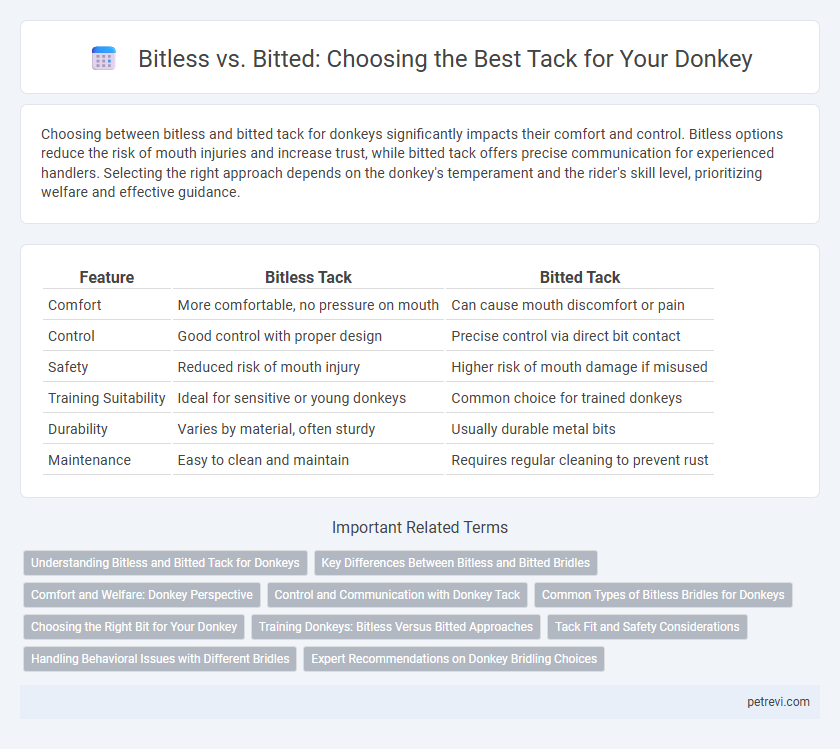Choosing between bitless and bitted tack for donkeys significantly impacts their comfort and control. Bitless options reduce the risk of mouth injuries and increase trust, while bitted tack offers precise communication for experienced handlers. Selecting the right approach depends on the donkey's temperament and the rider's skill level, prioritizing welfare and effective guidance.
Table of Comparison
| Feature | Bitless Tack | Bitted Tack |
|---|---|---|
| Comfort | More comfortable, no pressure on mouth | Can cause mouth discomfort or pain |
| Control | Good control with proper design | Precise control via direct bit contact |
| Safety | Reduced risk of mouth injury | Higher risk of mouth damage if misused |
| Training Suitability | Ideal for sensitive or young donkeys | Common choice for trained donkeys |
| Durability | Varies by material, often sturdy | Usually durable metal bits |
| Maintenance | Easy to clean and maintain | Requires regular cleaning to prevent rust |
Understanding Bitless and Bitted Tack for Donkeys
Bitless tack for donkeys improves comfort by avoiding pressure on the sensitive mouth while enhancing subtle communication through pressure on the nose and poll. Bitted tack offers precise control and responsiveness, especially beneficial for trained donkeys in complex tasks or trail riding. Choosing between bitless and bitted equipment depends on the donkey's temperament, training level, and intended use to ensure effective and humane handling.
Key Differences Between Bitless and Bitted Bridles
Bitless bridles for donkeys avoid pressure on the mouth by using nosebands and poll pressure, promoting comfort and reducing the risk of oral injury. Bitted bridles apply direct pressure to the donkey's mouth through a metal bit, offering precise control but potentially causing discomfort or sores if misused. Choosing between bitless and bitted tack depends on the donkey's sensitivity, training, and the rider's control needs.
Comfort and Welfare: Donkey Perspective
Bitless donkey tack enhances comfort by eliminating pressure on sensitive areas of the mouth, reducing stress and promoting natural behavior. Bitted tack can cause discomfort or injury due to bit pressure on the tongue and bars, potentially leading to resistance or pain. Prioritizing bitless options supports donkey welfare by fostering a gentler, pain-free communication during handling and riding.
Control and Communication with Donkey Tack
Bitless donkey tack enhances control and communication by applying pressure across the donkey's nose and jaw, promoting a gentler and more responsive connection. Bitted tack offers direct rein cues through the mouth, providing precise control but may cause discomfort or resistance if improperly fitted. Choosing between bitless and bitted tack depends on the donkey's sensitivity and the rider's preference for subtlety versus directness in communication.
Common Types of Bitless Bridles for Donkeys
Common types of bitless bridles for donkeys include the sidepull, which applies gentle pressure on the sides of the head, and the bosal-style hackamore, known for its flexible noseband that encourages responsive control without a bit. The mechanical hackamore features shanks that increase leverage pressure on the nose and chin, offering stronger guidance while remaining bitless. These options prioritize donkey comfort and communication, reducing mouth pressure and enhancing natural head movement compared to traditional bitted tack.
Choosing the Right Bit for Your Donkey
Selecting the appropriate bit for your donkey involves understanding their sensitivity and behavioral responses, with bitless options providing a gentler alternative that reduces pressure on the mouth and promotes comfort. Bitted tack offers more precise control and communication through rein cues, which can be beneficial for training or managing spirited donkeys. Evaluating your donkey's temperament, training level, and intended activities is essential for choosing between bitless and bitted tack to ensure safety and effective handling.
Training Donkeys: Bitless Versus Bitted Approaches
Bitless tack offers a gentler option for donkey training by avoiding pressure on the sensitive mouth area, promoting comfort and reducing resistance. Bitted tack provides precise control through direct pressure, which can be useful for advanced training but may cause discomfort if not used skillfully. Evaluating individual donkey temperament and training goals is crucial when choosing between bitless and bitted approaches for effective and humane handling.
Tack Fit and Safety Considerations
Bitless donkey tack offers a gentler fit that reduces pressure on the sensitive bars of the mouth, promoting comfort and reducing the risk of oral injuries compared to bitted options. Properly fitted bitless bridles distribute pressure more evenly across the donkey's head, enhancing safety by minimizing the chance of pain-induced resistance or behavioral issues. In contrast, bitted tack requires precise adjustment to avoid pinching or excessive pressure on the tongue and bars, demanding vigilant fit checks to ensure both control and the donkey's welfare.
Handling Behavioral Issues with Different Bridles
Bitless bridles for donkeys promote gentler control by applying pressure on the nose and poll, reducing the risk of mouth pain and behavioral resistance often seen with bitted bridles. Bitted bridles, while offering precise communication through the mouth, can cause discomfort leading to head tossing, refusal, or aggression in donkeys with sensitive mouths or past trauma. Selecting bitless options can enhance handling by minimizing stress responses and improving trust, especially in donkeys prone to behavioral issues linked to oral discomfort.
Expert Recommendations on Donkey Bridling Choices
Experts emphasize that bitless bridles are often preferred for donkeys due to their sensitive mouths, reducing stress and discomfort compared to traditional bitted options. Studies show bitless designs promote better communication and trust between donkey and handler, minimizing resistance and behavioral issues. Optimal donkey tack choices prioritize gentle control, with many trainers recommending soft, padded nosebands and ergonomic fit over rigid bits.
Bitless vs Bitted for Donkey Tack Infographic

 petrevi.com
petrevi.com